ngtwolf
Veteran Member
Hi All,
Last weekend I was given a Kaypro 2/84 that didn't work, since the previous owner (also a retro collector) didn't want to mess with troubleshooting or the space it took. Got it home, cleaned it up and started troubleshooting. There were a few physical issues like a broken keyboard connector that i've gotten working temporarily (I think, but I guess we'll see). Initially turning the machine on/off, the power would randomly come on. When it did come on, the power light would come on and the disk drives would spin. There was no display on the screen (if I look closely I can see some light, but very little.. adjusting both the brightness and internal subbrightness made no difference there - the CRT does light up though). I cleaned the machine, resocketed everything and used deoxit on the sockets and power plug. That seemed to solve the random power issues (at least for now). Checking the voltages on the board gave me +12, -12 and +5 voltages. Further troubleshooting noted that the Z80-1 cpu and one of the SIO chips got extremely hot. I swapped the Z80 with my Model 4 and it was indeed bad. I Swapped both of those chips for 'new' chips. As well, it seems the SY6545-1 gets fairly hot, but swapping that made no difference and I assume that's just a hot chip in general. All of the chips now are under 45C with the only ones getting warm being that SY6545 and the Z80 CPU, but still around 45C or less in the hottest area. I tested all the voltages on the board, they all get about 4.9v (except two 12v chips) with the Z80 CPU getting around 4.7V. The ROM in the machine is correct with the 81-292A version (loaded and compared with my eprom burner, at least the first page). It does have a different character rom then is normal for that machine, don't think that matters however at this point. I used IMD to create a 2.2G SSDD disk, but inserting the disk does nothing and it doesn't attempt to read. The floppy drives, while constantly spinning, don't ever turn on the lights (I did clean and oil the drives in the initial cleaning process, as an aside, and physically they look good). The voltage on the drives appear correct as well.
So, at this point I think i've exhausted basic troubleshooting and looking towards some ideas of what my next steps would be? I do have a scope though my skills with it are pretty limited, so it's usually not my first approach.
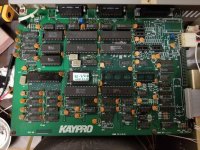

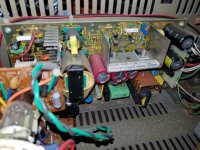
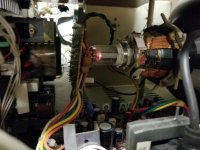
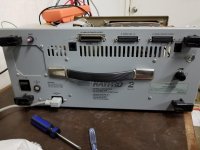
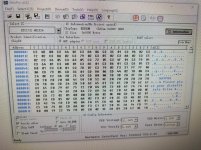
Thanks!
Last weekend I was given a Kaypro 2/84 that didn't work, since the previous owner (also a retro collector) didn't want to mess with troubleshooting or the space it took. Got it home, cleaned it up and started troubleshooting. There were a few physical issues like a broken keyboard connector that i've gotten working temporarily (I think, but I guess we'll see). Initially turning the machine on/off, the power would randomly come on. When it did come on, the power light would come on and the disk drives would spin. There was no display on the screen (if I look closely I can see some light, but very little.. adjusting both the brightness and internal subbrightness made no difference there - the CRT does light up though). I cleaned the machine, resocketed everything and used deoxit on the sockets and power plug. That seemed to solve the random power issues (at least for now). Checking the voltages on the board gave me +12, -12 and +5 voltages. Further troubleshooting noted that the Z80-1 cpu and one of the SIO chips got extremely hot. I swapped the Z80 with my Model 4 and it was indeed bad. I Swapped both of those chips for 'new' chips. As well, it seems the SY6545-1 gets fairly hot, but swapping that made no difference and I assume that's just a hot chip in general. All of the chips now are under 45C with the only ones getting warm being that SY6545 and the Z80 CPU, but still around 45C or less in the hottest area. I tested all the voltages on the board, they all get about 4.9v (except two 12v chips) with the Z80 CPU getting around 4.7V. The ROM in the machine is correct with the 81-292A version (loaded and compared with my eprom burner, at least the first page). It does have a different character rom then is normal for that machine, don't think that matters however at this point. I used IMD to create a 2.2G SSDD disk, but inserting the disk does nothing and it doesn't attempt to read. The floppy drives, while constantly spinning, don't ever turn on the lights (I did clean and oil the drives in the initial cleaning process, as an aside, and physically they look good). The voltage on the drives appear correct as well.
So, at this point I think i've exhausted basic troubleshooting and looking towards some ideas of what my next steps would be? I do have a scope though my skills with it are pretty limited, so it's usually not my first approach.






Thanks!
